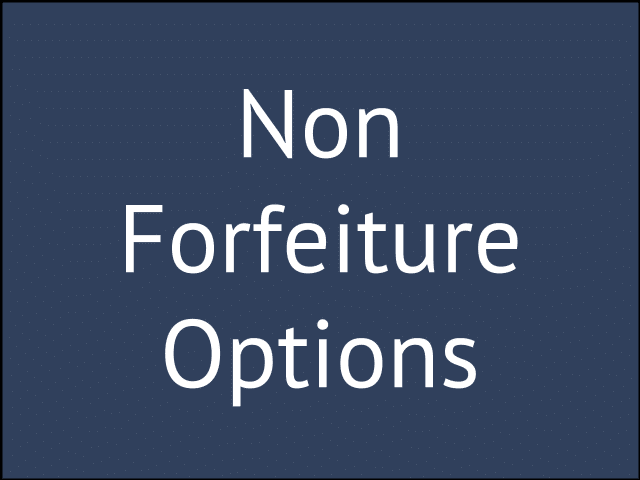Have you been in a circumstance where you can’t pay your life insurance premiums? One way of solving such a problem is by using nonforfeiture. Although Oftentimes, some people believe the solution is to ignore the premium notice and that’s all. However, there is nothing to worry about. This article is a step by step guide to what nonforfeiture options are and their life insurance benefits.
What Are Nonforfeiture Options?
A nonforfeiture option is a clause in your policy that allows you to receive full or partial benefits from your life insurance.

In other words, they are a feature of whole life insurance policies. These options allow you to stop paying premiums. Thus, you can cash your policy in, and buy a reduced paid-up insurance. Meanwhile, the extended-term nonforfeiture option has the same face amount as the original policy, but it’s for a short period of time.
One major reason for embracing the nonforfeiture option is because those life insurance policies that accumulate cash value will require a nonforfeiture value.
A policyholder can opt to move the cash value of their whole life policy into paid-up insurance. In such a situation, the policy is not paid up in the stringent boundary of the term. Although it is competent enough of making its own premium payments.
Sometimes, depending on the type of policy, a policyholder may have to resume premium payments in the future.
What Are the Three Nonforfeiture Options?
There are potentially three nonforfeiture options you can use. They include:
#1. Cash surrender
Wikipedia puts it that an insurance contract’s cash value also called the cash surrender value or surrender value is the cash amount offered to the policyholder by the issuing life carrier upon cancellation of the contract. This term is normally used with a life insurance or life annuity contract.
Therefore it simply involves cashing your policy in. The Insurance company provides you with a check for the net cash value by the insurance company. Then you can do whatsoever you want with the money. You can also use the cash surrender option if you need the cash.
The policy owner receives the remaining cash value within six(6) months under the nonforfeiture cash payment option. Cash surrender value also applies to the savings terms of whole life insurance policies before death. In addition, during the early years of a whole life insurance policy, the savings part brings a small return equalled to the paid premiums.
#2. Reduced paid-up insurance
You can use the cash value to purchase a whole life policy. It will be less than the original face amount and since it is paid up, it requires no premiums. You’ll just own that amount of life insurance from that point forward until you die.
#3. Extended term insurance
Extended-term insurance also allows a policyholder to quit paying the premiums but does not allow you to forfeit the equity of their policy. The cash value you will have in your built-in policy will be lessened by the amount of any loans against it.
Meanwhile, you can use the cash value to keep the original life insurance to cover the amount. This is only for a limited time. The term period depends on the cash value of the policy. Once it’s changed to a lengthened term, you certainly won’t have to pay premiums again.
What is the meaning of nonforfeiture option?
A non-forfeiture option (or clause) is a provision added in certain life insurance policies that stipulates the policyholder will not lose the value of the policy if the policy terminates due to missed premium payments after a specified period.
Which of the following is an illustration of the Nonforfeiture alternative?
Cash surrender is one of the three types of nonforfeiture alternatives accessible. Reduced paid-up insurance premiums. Long-term insurance coverage
What purpose do Nonforfeiture alternatives serve?
Nonforfeiture: Long-Term Care Insurance policies must give a nonforfeiture benefit. The nonforfeiture benefit is intended to ensure that if you allow your policy to lapse (i.e. stop paying premiums) after a certain number of years, you will keep some policy benefit
Nonforfeiture Benefits
A nonforfeiture option benefit is an insurance policy prerequisite specifying that an insured’s equity in the policy cannot be forfeited. This benefit offers the insured options for taking the cash value of a policy that lapses. However, there are some common types of nonforfeiture benefits such as are the policy’s cash surrender value, or a loan.
Also, nonforfeiture option benefit must be given with long term Care Insurance policies. The nonforfeiture benefit ensures that if you stop paying premiums after a given number of years, you retain some benefits from the policy.
However, there are currently two common types of nonforfeiture benefits with certain insurance policies covering long term care services.
Read Also: Personal Finance: Basics, Importance, Types, Management ( + Free Softwares)
#1. Reduced Paid-Up Benefit
When you obtain a reduced paid-up benefit, it will show that if you lapse your policy after a specified number of years, the policy will extend with reduced daily benefit amounts.
#2. Shortened Benefit Period
In this case, if you obtain a shortened benefit period, it will outline that if you lapse your policy after a given number of years, the policy will continue to cover the same benefits that would have been covered under your policy until the nonforfeiture benefit amount is consumed.
In other words, the “Reduced Paid-Up Benefit” provides a condensed benefit for the original term of the policy. Thus a “Shortened Benefit Period” gives full benefits for a reduced duration of time.
Nonforfeiture Options Life Insurance
Whole life insurance allows three nonforfeiture options as explained above. It ensures policy owners receive value from their policies.
Therefore if the policy is converted into term life insurance (extended-term option), then it will have the same face value as the original policy. However, the term will be determined by the cash value of the policy. Are you hooked up? Let me explain further! This automatically means that the greater the cash value and the lower the face amount of the policy, the longer the term. Thus, any policy that is turned or converted to term insurance can be substituted under the reinstatement provision of the agreement.
Conclusion
A Nonforfeiture Option is also known as a Secured Value Option. It is an option available to a policy owner who has stopped paying premiums under a permanent life insurance policy.
However, in the text, I have outlined three non-forfeiture or cash surrender options. A nonforfeiture option has enormous cost variation among related life insurance policies.
Therefore, when shopping for life insurance, we recommend that you decide on the best type of insurance for you, consider a policy that pays dividends, shop for a low-cost policy, look into your financial strength as well as consulting with a competent agent, insurance companies or financial institutions.






